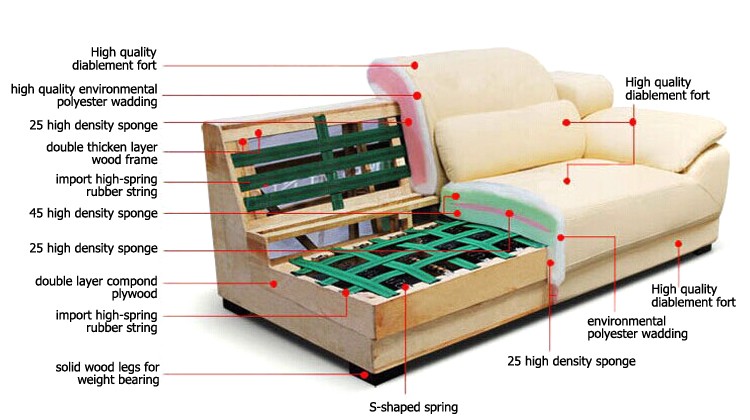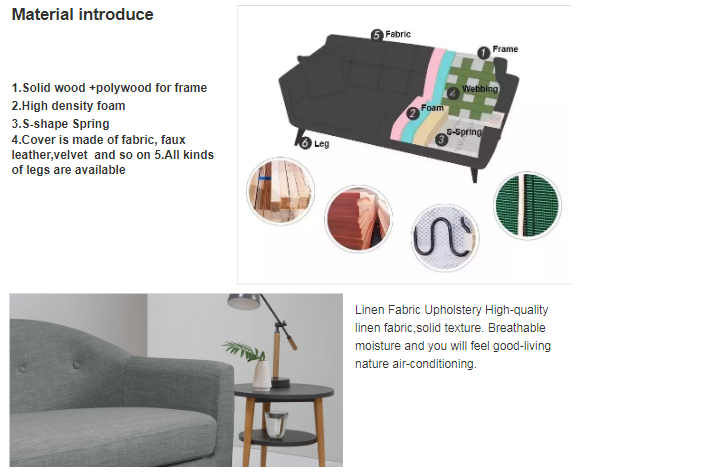Title: Exploring the Intricacies of Sofa Structure: A Comprehensive Guide
The sofa, an iconic piece of furniture in any home, is more than just a place to sit. It's a work of art that combines style and comfort. But have you ever wondered how exactly it's made? The structure of a sofa is intricate and complex, involving a variety of materials and techniques. This comprehensive guide explores the various components of a sofa and their functions. From the frame to the cushions, we delve into the science behind this seemingly simple piece of furniture. We examine the different types of frames available, such as metal or wood, and their respective advantages and disadvantages. We also explore the materials used for cushioning, including foam, feathers, and down. Additionally, we discuss the importance of upholstery and the various techniques used in its creation. By understanding the intricacies of sofa structure, you can better appreciate the craftsmanship that goes into each piece. Whether you're a seasoned furniture collector or simply looking to add some new pieces to your home, this guide is a must-read. So grab a cup of coffee, sit back, and let's dive into the world of sofas.
The sofa, an integral piece of furniture in any living space, is not only a place to relax but also serves as a centerpiece for social gatherings. Its comfort and versatility make it a popular choice for homes of all sizes. However, few people stop to consider the complex structure that underlies this ubiquitous piece of furniture. In this article, we will delve into the anatomy of a sofa, exploring its various components and their roles in creating its overall function and appeal.
The frame is the backbone of any sofa. It provides support and stability, allowing the cushions to sit smoothly against it. There are several types of frames available, each with its own unique advantages and drawbacks. Some frames are made from wood, adding a natural aesthetic to the space while providing durability. Others are made from metal or plastic, which can be more resistant to wear and tear but may not exude the same warmth as wood. The frame is typically constructed with interlocking pieces, which together form a solid and secure structure.
The cushion is the most visible component of a sofa, but it is just as important as the frame. The cushion's shape and material can greatly impact a person's comfort level when sitting on the sofa. Foam cushions are commonly used because they provide adequate support while also being comfortable. Memory foam cushions, on the other hand, adapt to the shape of the body, providing even more comfort. Some sofas also come with removable and washable cushions, offering added convenience.

Cushions are often attached to the frame by way of a zipper or hook-and-loop system. These systems ensure a secure fit and allow for easy maintenance. The depth of the cushion is another critical factor to consider. Deeper cushions provide more support and are ideal for long periods of sitting, while shallow cushions are better for lounging and don't offer the same level of support.
The armrests are another essential component of a sofa. They add functionality and comfort by providing a place to rest one's arms while sitting. The armrests can be built-in or added as an optional feature. Some sofas also have reclining capabilities, allowing the user to adjust the angle of the backrest to achieve maximum comfort.
The sofa's upholstery is what gives it its appearance and texture. Upholstery materials include leather, fabric, microfiber, suede, velour, and many others. Each material has its own set of benefits and drawbacks. Leather is durable and easy to clean, but it can be expensive and may not be suitable for everyone's taste. Fabric upholstery is more affordable and comes in a wide range of styles and colors, but it may not be as durable as other materials. Microfiber is soft and hypoallergenic, making it a popular choice for those with allergies or sensitivities.
The legs of the sofa are another important part of its structure. They provide support and stability while also enhancing the aesthetic of the piece. Legs can be wooden, metal, or plastic, and they may be straight or curved depending on the style of the sofa. Some sofas have adjustable legs for greater customization and flexibility in placement.

In addition to these primary components, many sofas also feature additional features such as throw pillows, decorative accents, and storage solutions. These elements can further enhance the overall look and function of the sofa while also providing practical benefits such as increased comfort and organization.
Understanding the intricate details of a sofa's structure is crucial for selecting the right piece for your home and ensuring its long-term satisfaction. By taking into account factors such as frame type, cushion material, armrest design, upholstery material, leg construction, and additional features, you can create a comfortable and functional living space that meets your needs and enhances your lifestyle.
Articles related to the knowledge points of this article:
Title: The Symbolic Significance of a White Tie in Various Cultural Contexts
Title: The Art of Tie Knotting: A Comprehensive Guide to Tie Knots for Men
Shopping for a Down Jacket: A Guide to Staying Warm This Winter
Feathered Dreams and Broken Holes: The Story of a Torn-Up Jacket
Title: Unveiling the Enigmatic Allure of Silk Scarves and Belts
Title: Mastering the Art of Tie-Dying Scarves: A Comprehensive Guide to Tying Silk Scarves



